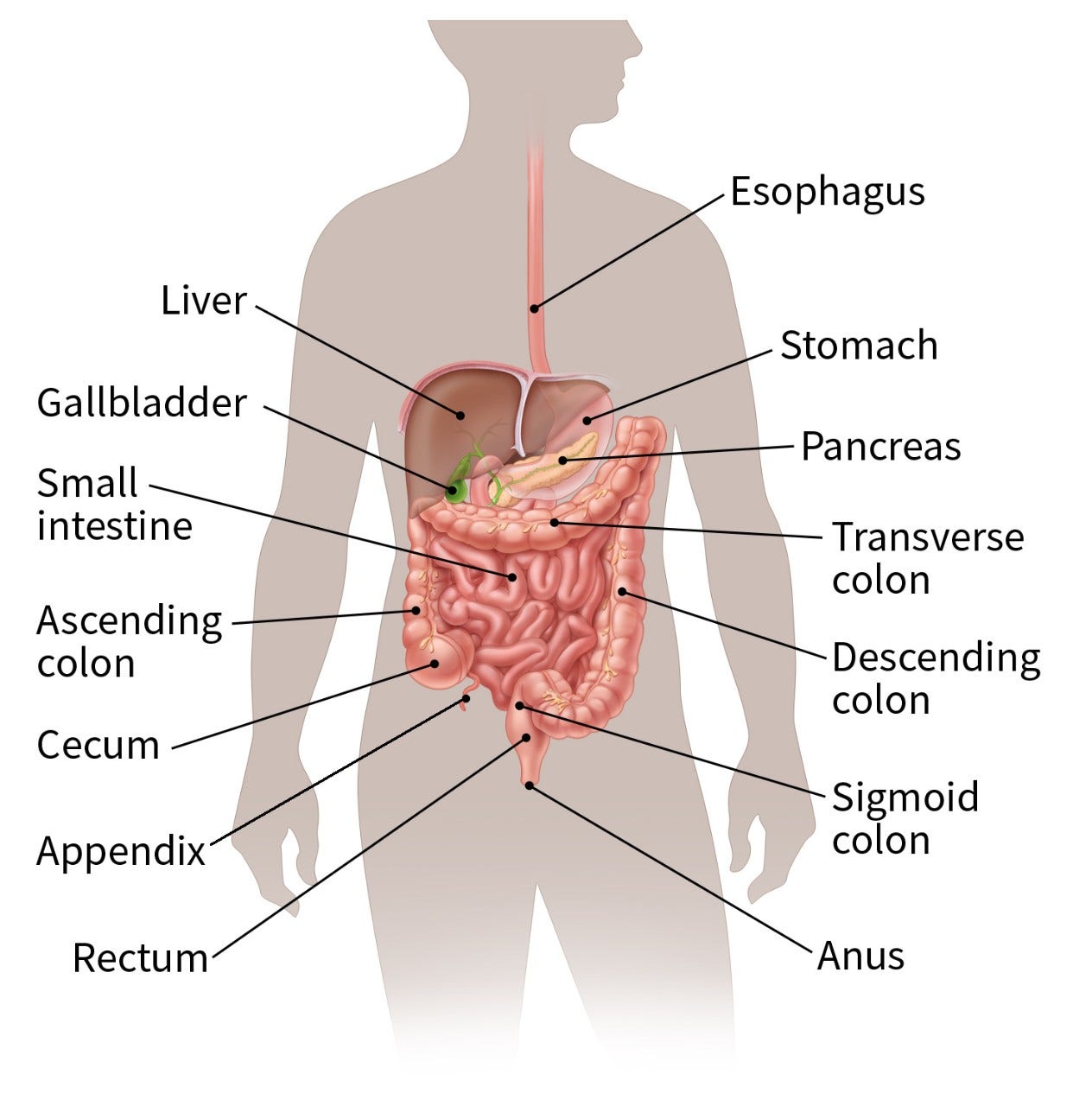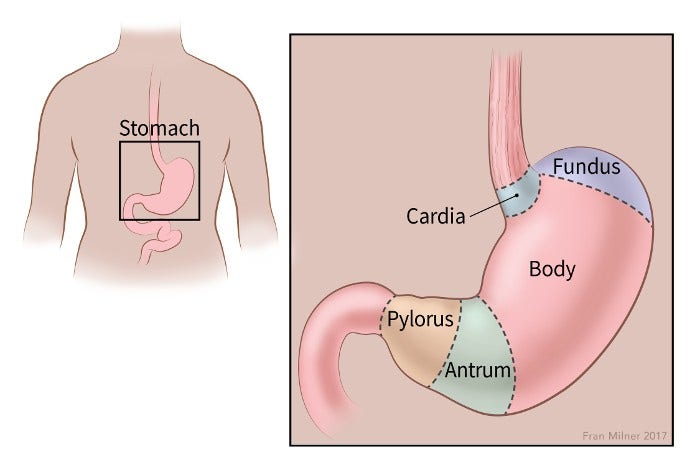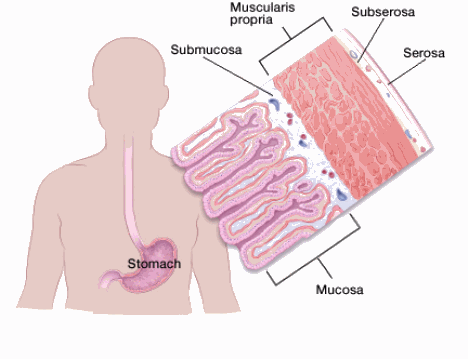Your gift is 100% tax deductible
What Is Stomach Cancer?
Cancer starts when cells in the body begin to grow out of control. Cells in nearly any part of the body can become cancer, and can then spread to other areas of the body. To learn more about cancer and how it starts and spreads, see What Is Cancer?
Stomach cancer, also called gastric cancer, begins when cells in the stomach start to grow out of control.
The stomach
To understand stomach cancer, it helps to know about the normal structure and function of the stomach.

The stomach is a sac-like organ that’s an important part of the digestive system.
After food is chewed and swallowed, it enters the esophagus, a tube that carries food through the throat and chest to the stomach. The esophagus joins the stomach at the gastroesophageal (GE) junction, which is just beneath the diaphragm (the thin sheet of breathing muscle under the lungs). The stomach then starts to digest the food by secreting gastric juice. The food and gastric juice are mixed and then emptied into the first part of the small intestine called the duodenum.
Some people use the word 'stomach' to refer to the belly area. The medical term for this area is the abdomen. For instance, some people with pain in this area would say they have a 'stomach ache', when in fact the pain could be coming from some other organ in the area. Doctors would call this symptom 'abdominal pain,' because the stomach is only one of many organs in the abdomen.
Stomach cancer is different from other cancers that can occur in the abdomen, like cancer of the colon or rectum (large intestine), liver, pancreas, or small intestine. These cancers can have different symptoms, different outlooks, and different treatments.
Parts of the stomach
The stomach has 5 parts.

The first 3 parts make up the proximal stomach:
- Cardia: the first part, which is closest to the esophagus
- Fundus: the upper part of the stomach next to the cardia
- Body (corpus): the main part of the stomach, between the upper and lower parts
Some cells in these parts of the stomach make acid and pepsin (a digestive enzyme), which combine to make the gastric juice that helps digest food. They also make a protein called intrinsic factor, which the body needs to absorb vitamin B12.
The lower 2 parts make up the distal stomach:
- Antrum: the lower portion (near the small intestine), where the food mixes with gastric juice
- Pylorus: the last part of the stomach, which acts as a valve to control the emptying of the stomach contents into the small intestine
Other organs near the stomach include the small intestine, colon, liver, spleen, and pancreas.
The stomach wall has 5 layers:

- The innermost layer is the mucosa. This is where stomach acid and digestive enzymes are made. Most stomach cancers start in this layer.
- Next is a supporting layer called the submucosa.
- Outside of this is the muscularis propria, a thick layer of muscle that helps move and mix the stomach contents.
- The outer 2 layers, the subserosa and the outermost serosa, wrap the stomach.
The layers are important in determining the stage (extent) of the cancer, which can affect a person’s treatment options and prognosis (outlook). As a cancer grows from the mucosa into deeper layers, the stage becomes more advanced and treatment might need to be more extensive.
Development of stomach cancer
Stomach cancers tend to develop slowly over many years. Before a true cancer develops, pre-cancerous changes often occur in the inner lining (mucosa) of the stomach. These early changes rarely cause symptoms, so they often go undetected.
Cancers starting in different sections of the stomach can cause different symptoms and tend to have different outcomes. The cancer’s location can also affect treatment options. For example, cancers that start at or grow into the GE junction are usually staged and treated the same as cancers of the esophagus. (For more information, see Esophagus Cancer.)
Types of stomach cancer
Adenocarcinomas
Most cancers of the stomach (about 90% to 95%) are adenocarcinomas. These cancers develop from the gland cells in the innermost lining of the stomach (the mucosa).
If you are told you have stomach cancer (or gastric cancer), it will almost always be an adenocarcinoma. The information on the following pages that discusses stomach cancer refers to this type of cancer.
There are 2 main types of stomach adenocarcinomas:
- The intestinal type tends to have a slightly better prognosis (outlook). The cancer cells are more likely to have certain gene changes that might allow for treatment with targeted drug therapy.
- The diffuse type tends to grow spread more quickly. It is less common than the intestinal type, and it tends to be harder to treat.
Other types of cancer that can start in the stomach
Gastrointestinal stromal tumors (GISTs)
These uncommon tumors start in very early forms of cells in the wall of the stomach called interstitial cells of Cajal. Some GISTs are much more likely than others to grow into other areas or spread to other parts of the body. Although GISTs can start anywhere in the digestive tract, most start in the stomach. For more information, see Gastrointestinal Stromal Tumor (GIST).
Neuroendocrine tumors (including carcinoids)
Neuroendocrine tumors (NETs) start in cells in the stomach (or other parts of the digestive tract) that act like nerve cells in some ways and like hormone-making (endocrine) cells in others. Most NETs tend to grow slowly and do not spread to other organs, but some can grow and spread quickly. NETs are discussed in more detail in Gastrointestinal Neuroendocrine (Carcinoid) Tumors.
Lymphomas
These cancers start in immune system cells called lymphocytes. Lymphomas usually start in other parts of the body, but some can start in the wall of the stomach. The treatment and outlook for these cancers depend on the type of lymphoma and other factors. For more information, see Non-Hodgkin Lymphoma.
Other cancers
Other types of cancer, such as squamous cell carcinomas, small cell carcinomas, and leiomyosarcomas, can also start in the stomach, but these cancers are very rare.
- Written by
- References

The American Cancer Society medical and editorial content team
Our team is made up of doctors and oncology certified nurses with deep knowledge of cancer care as well as editors and translators with extensive experience in medical writing.
Ku GY, Ilson DH. Chapter 72: Cancer of the Stomach. In: Niederhuber JE, Armitage JO, Doroshow JH, Kastan MB, Tepper JE, eds. Abeloff’s Clinical Oncology. 6th ed. Philadelphia, Pa: Elsevier; 2020.
Goldberg RM. Pathology and molecular pathogenesis of gastric cancer. UpToDate. 2020. Accessed at https://www.uptodate.com/contents/pathology-and-molecular-pathogenesis-of-gastric-cancer on May 20, 2020.
National Cancer Institute. Physician Data Query (PDQ). Gastric Cancer Treatment. 2020. Accessed at https://www.cancer.gov/types/stomach/hp/stomach-treatment-pdq on May 20, 2020.
National Comprehensive Cancer Network (NCCN). Practice Guidelines in Oncology: Gastric Cancer. Version 2.2020. Accessed at https://www.nccn.org/professionals/physician_gls/pdf/gastric.pdf on May 21, 2020.
Last Revised: January 22, 2021
American Cancer Society medical information is copyrighted material. For reprint requests, please see our Content Usage Policy.
American Cancer Society Emails
Sign up to stay up-to-date with news, valuable information, and ways to get involved with the American Cancer Society.



